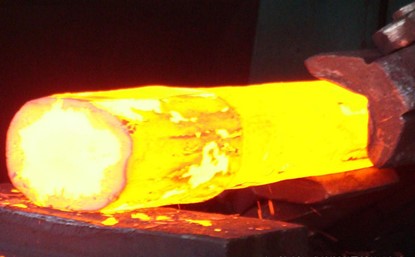In the forging process, upsetting refers to the deformation of a workpiece to increase its diameter by compressing its height. A critical parameter in upsetting is the height-to-diameter ratio (H/D ratio), which plays a key role in determining the quality of the final product and the feasibility of the process. The height-to-diameter ratio is used to ensure the deformation remains controlled and uniform, preventing issues such as buckling, cracking, or material failure.
What is the Height-to-Diameter Ratio?
The height-to-diameter ratio (H/D ratio) is the ratio between the height (or length) of the workpiece and its diameter before forging. This ratio helps define how much a material can be deformed through the upsetting process. Typically, the smaller the ratio, the more feasible the upsetting process becomes because shorter, thicker materials can withstand greater compressive forces without buckling or developing defects.
For example, a lower H/D ratio, such as 1.5:1 or lower, indicates a stubby workpiece, which can handle high compressive loads without significant risks of instability. On the other hand, a higher ratio, such as 3:1 or more, would require more careful consideration, as the workpiece becomes more prone to deformation defects.
How to Determine the Optimal H/D Ratio?
The ideal H/D ratio depends on several factors, including material properties, the temperature of the material during forging, and the degree of deformation required. Here are the main steps for determining the optimal H/D ratio for upsetting:
- Material Properties: Different materials exhibit different compressive strengths and ductility. Softer materials, such as aluminum, can endure more deformation without cracking, while harder materials like high-carbon steel may require a lower H/D ratio to avoid excessive stress. The flow stress of the material, i.e., the stress required to continue deforming the material plastically, must be considered.
- Temperature Conditions: Hot forging is typically performed at temperatures that improve material ductility and reduce the required force. Higher temperatures allow for larger deformation, which permits a greater height-to-diameter ratio. For cold forging, the H/D ratio should be kept smaller due to the increased risk of work hardening and cracking.
- Degree of Deformation: The amount of deformation required is another important aspect. If a significant reduction in height is needed, starting with a lower H/D ratio is beneficial to ensure the workpiece can undergo the required compression without defects.
- Avoiding Defects: When determining the H/D ratio, it is essential to avoid defects such as buckling, which occurs when the material folds or wrinkles during compression. To avoid buckling, a typical rule of thumb is to use an initial H/D ratio of less than 2:1 for general upset forging. Additionally, lubrication and proper die design are crucial to minimize friction and ensure uniform deformation.
Practical Example
Consider the case of upsetting a cylindrical billet of steel. If the initial height of the billet is 200 mm and the diameter is 100 mm, the H/D ratio would be 2:1. If the material is relatively soft, and hot forging is employed, this ratio may be acceptable. However, if cold forging is used, reducing the height to decrease the H/D ratio may be necessary to avoid buckling or cracking during the upsetting process.
Conclusion
The height-to-diameter ratio in upsetting is a fundamental aspect of forging that determines the success of the process. By carefully evaluating material properties, temperature, and deformation requirements, an optimal ratio can be established, ensuring the production of high-quality, defect-free forged components.
Post time: Sep-18-2024





